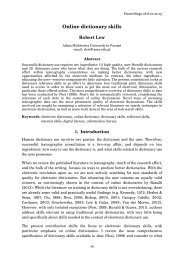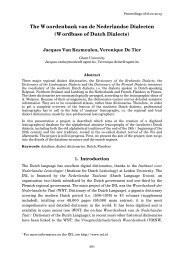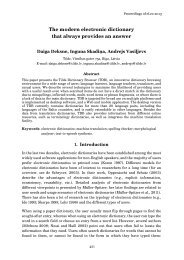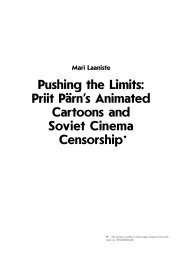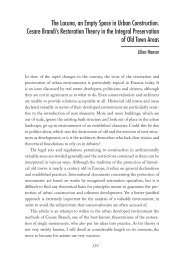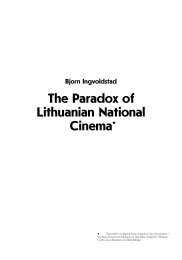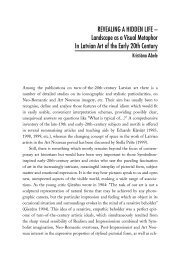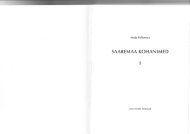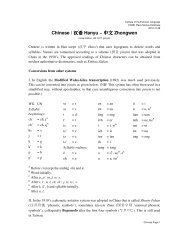LOCATIONS in INTERSEMIOTIC SPACE*
LOCATIONS in INTERSEMIOTIC SPACE*
LOCATIONS in INTERSEMIOTIC SPACE*
Create successful ePaper yourself
Turn your PDF publications into a flip-book with our unique Google optimized e-Paper software.
Peeter Torop<br />
As the third stage, we can name the treatment of text as a mechanism gener-<br />
at<strong>in</strong>g language i.e., as a dialogic whole. Lotman consciously replaced the notion<br />
of reception with the term of communication, and thus <strong>in</strong>sisted upon the dialogic<br />
activity of text. At the meet<strong>in</strong>g of a text with the addressee there can appear sev-<br />
eral communicative levels, simultaneously or separately: text as a message means<br />
communication between the addressee and the addressant, text as a bearer of the<br />
collective cultural memory means communication between the cultural tradition<br />
and the audience, text as a mediator <strong>in</strong>fluenc<strong>in</strong>g the shap<strong>in</strong>g of personality means<br />
communication of the reader with him/herself, text as an <strong>in</strong>dependent <strong>in</strong>tellec-<br />
tual conglomeration and an autonomous dialogue partner means communication<br />
of the reader with the text, and text as a full-value partner <strong>in</strong> a communication act<br />
means communication between the text and cultural context (Lotman 1981: 6).<br />
In the case of dialogical treatment of text, space has changed – the textual<br />
space has turned <strong>in</strong>to a cultural space, and the text as an artefact produced from a<br />
material, has become a cultural text. is change has been put <strong>in</strong>to written form<br />
already <strong>in</strong> the theses of the Tartu-Moscow cultural semiotics (1973): ‘In def<strong>in</strong><strong>in</strong>g<br />
culture as a certa<strong>in</strong> secondary language, we <strong>in</strong>troduce the concept of a ‘culture<br />
text’, a text <strong>in</strong> this secondary language. So long as some natural language is a part<br />
of the language of culture, there arises the question of the relationship between<br />
the text <strong>in</strong> the natural language and the verbal text of culture.’ (eses 1973: 43.)<br />
e eses of 1973 are also important with regard to the relation between parts<br />
and the whole: ‘e relationship of the text with the whole of culture and with<br />
its systems of codes is shown by the fact,that on different levels the same message<br />
may appear as a text, part of a text, or an entire set of texts.’ (eses 1973: 38.)<br />
Yuri Lotman’s evolution cont<strong>in</strong>ues clearly homologously towards the notion<br />
of the semiosphere. First, semiosphere establishes the dynamics between the part<br />
and the whole: ‘S<strong>in</strong>ce all the levels of the semiosphere – rang<strong>in</strong>g from a human<br />
<strong>in</strong>dividual or an <strong>in</strong>dividual text to global semiotic unities – are all like semio-<br />
spheres <strong>in</strong>serted <strong>in</strong>to each other, then each and one of them is both a participant<br />
<strong>in</strong> the dialogue (a part of the semiosphere) as well as the space of the dialogue (an<br />
entire semiosphere).’ (Lotman 1984: 22.) Second, this whole–part relationship is<br />
jo<strong>in</strong>ed, <strong>in</strong> turn, by the dynamics between the subjective and objective: ‘e struc-<br />
tural parallelism between semiotic characteristics of a text and of a personality<br />
enables us to def<strong>in</strong>e any text on any level as a semiotic personality, and to regard<br />
any personality on any sociocultural level as a text.’ (Lotman 1992: 116.)<br />
60



